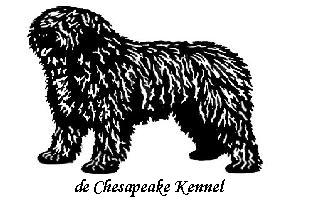


 |
|||||||||||||||||||||
|
|
|
||||||||||||||||||||
|
|
|||||||||||||||||||||
 The Spanish Water Dog is the perfect complement to a family's active outdoor lifestyle. Hunting, fishing, boating, camping, and biking, the Spanish Water Dog is a companion of distinction. These dogs are just as comfortable in the urban setting as they are on the river or a wilderness journey. A go-anywhere, sporting companion.
We invite you to submit your adventures with your de Chesapeake Spanish Water Dog. Just email your pictures to SpanishWaterDog@Yahoo.com with your dog's name and location of the adventure.
De Chesapeake Projected Mating Calendar
Listed 2014/15 matings are projections and are subject to change.
All puppies are UKC registered but carry limited restrictions for purposes of breeding.
Mattie x Willie March 2016 May 2016 Lucy x Willie De Chesapeake Kennels specializes in the breeding, training and importation of fine Spanish Water Dogs. Our SWDs, whether they are puppies, started or finished retrievers are best categorized in character, temperament and ability as a Gentleman's Gundog.
Puppy Training Before pup comes home give some thought to how you want your adult dog to behave. Discuss your expectations and rules with all of your family members. It is very important that a family has only one set of rules. No matter how cute it may be for a little puppy to jump up on people and race around, out of fairness to your puppy, be consistent. Do not encourage the puppy to do things that will be forbidden when he/she is fully grown.
Training starts the moment you get your puppy home. Do not expect your puppy to be rational or to understand what you are trying to teach him. He must be shown each step, and will learn how to learn as you proceed with his training. For now the best approach is a positive reinforcement of acceptable behavior. Punishment is pointless because a puppy lacks the sophistication to understand the punishment as a consequence of his behavior.
A key concept to remember is that almost everything your puppy does is normal puppy behavior and not done out of spite or stubbornness. It is your job to teach him acceptable behavior through positive reinforcement. The main strategy of puppy training is to control the environment, the stimuli and temptations that influence his behavior. Choosing a planned activity puts you in control and gives you the opportunity to reward good behavior.
A dog crate is a necessary tool for positive reinforcement. By confining pup in a crate any time he cannot be supervised you prevent unwanted behavior. Use of a crate also makes housebreaking easier. By confining your pup in a small space you force him to exert control. When you take him out of the crate you can be reasonably sure he will relieve himself, allowing you the opportunity to praise him.
When teaching commands it is best to use a two word approach. The first word is the preparatory command. This word is normally the pupís name. This word will get the pups attention. The next word is the command, sit, heal, come etc. Though repetitions your pup will learn that every time he hears his name he will stop what he is doing and look at you in anticipation of a command. I also want to add that puppies have keen hearing, commands should be spoken softly or with a natural voice, never resort to yelling. Set the puppy up for success, control the environment and never give a command that you are not ready to reinforce.
Common Puppy Issues to Avoid:
1. Tug-of war: tug-of-war is a competitive game. It puts you and your puppy on an equal footing. You are the pack leader. 2. Chasing: puppies have a built in chase response. If you chase your puppy he will run away. In your pups mind it is a fun game of keep away. The goal is for pup to come when called. Never chase your dog. 3. Rolling Over: rolling over is a submissive behavior when a pup rolls over on his back. STOP all attention and walk away. 4. Destructive chewing: destructive chewing avoid leaving puppy unsupervised. 5. Biting: most puppies vigorously attack and bite hands and pants cuffs. If left unchecked this behavior will soon progress to drawing blood. a. Many inexperienced dog owners hold and move their hands near a pupís face in a manner that seems to trigger biting. Instead pick up puppy and hold him. |
|
|
|
|
Work-Intelligence-Beauty Copyright © de Chesapeake Kennel All rights reserved
| Site Map |